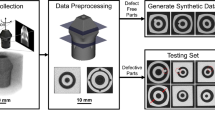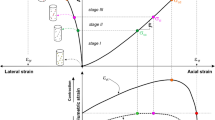Abstract
With the rapid development of Industry 4.0 and the expansion of its application fields, it has been successfully applied in various industrial applications like aerospace, defense, material manufacturing, etc. For quality control, nondestructive testing and evaluation (NDT&E) will become nondestructive testing and evaluation (NDE) 4.0 to seamlessly connect with Industry 4.0. NDE 4.0 focuses on deploying artificial intelligence in the quality inspection of different industrial products, including composites, steel slabs, polycrystalline solar wafers, etc. This paper proposes an artificial neural network (ANN) based sub-surface defect detection modality for exploring subsurface defects using Gabor filter features with improved resolution and enhanced detectability. Considering the desirable characteristics of spatial locality and orientation selectivities of the Gabor filter, we design filters for extracting sample features from the local image. The effectiveness of the proposed method is demonstrated by the experimental results on glass fiber reinforced polymer (GFRP) composite sample using digitized frequency modulated thermal wave imaging. We experimentally evaluate the proposed model on a benchmark and achieve a fast detection result with high accuracy, surpassing the state-of-the-art methods. For quantification, signal to noise ratio (SNR) is considered as a figure of merit.









Similar content being viewed by others
Data Availability
The results presented in this manuscript have no associated data.
References
Xu, L. D., Xu, E. L., & Li, L. (2018). Industry 4.0: State of the art and future trends. International Journal of Production Research, 56(8), 2941–2962.
Johannes, V., Norbert, M., Nathan, I., & Singh, R. (2022). Handbook of nondestructive evaluation 4.0. Springer.
Duan, Y., Liu, S., Hu, C., Hu, J., Zhang, H., Yan, Y., Tao, N., Zhang, C., Maldague, X., & Fang, Q. (2019). Automated defect classification in infrared thermography based on a neural network. NDT&E International, 107, 102147.
Wang, B., Zhong, S., Lee, T. L., Fancey, K. S., & Mi, J. (2020). Non-destructive testing and evaluation of composite materials/structures: A state-of-the-art review. Advances in Mechanical Engineering, 12(4), 1687814020913761.
Maldague, X. (2001). Theory and practice of infrared technology for nondestructive testing. Wiley.
Balageas, D. L., Krapez, J. C., & Cielo, P. (1986). Pulsed photothermal modeling of layered materials. Journal of Applied Physics, 59, 348–357.
Busse, G., Wu, D., & Karpen, W. (1992). Thermal wave imaging with phase sensitive modulated thermography. Journal of Applied Physics, 71, 3962–3965.
Fang, Q., Nguyen, B. D., Castanedo, C. I., Duan, Y., & Maldague, I. I. X. (2020). Automatic defect detection in infrared thermography by deep learning algorithm. In Thermosense: Thermal infrared applications XLII SPIE (pp. 180–195).
Lakshmi, A. V., Ghali, V. S., Subhani, S. K., & Baloji, N. R. (2020). Automated quantitative subsurface evaluation of fiber reinforced polymers. Infrared Physics and Technology, 110, 103456.
Vesala, G. T., Ghali, V. S., Sastry, D. V. A. R., & Naik, R. B. (2022). Deep anomaly detection model for composite inspection in quadratic frequency modulated thermal wave imaging. NDT&E International, 132, 102710.
Maldague, X., & Marinetti, S. (1996). Pulse phase infrared thermography. Journal of Applied Physics, 79, 2694–2698.
Gleiter, A., Riegert, G., Zweschper, T., & Busse, G. (2007). Ultrasound lock-in thermography for advanced depth resolved defect selective imaging. Insight: Non-destructive Testing and Condition Monitoring, 49(5), 272–274.
Arora, V., Mulaveesala, R., Rani, A., Kumar, S., Kher, V., Mishra, P., Kaur, J., Dua, G., & Jha, R. K. (2021). Infrared image correlation for non-destructive testing and evaluation of materials. Journal of Nondestructive Evaluation, 40, 1–7.
Yao, Y., Sfarra, S., Lagüela, S., Ibarra-Castanedo, C., Wu, J. Y., Maldague, X. P., & Ambrosini, D. (2018). Active thermography testing and data analysis for the state of conservation of panel paintings. International Journal of Thermal Sciences, 126, 143–151.
Dudek, G., & Dudzik, S. (2018). Claassification tree for material defect detection using active thermography. Advances in Intelligent Systems and Computing, 655, 118–127.
Mulaveesala, R., & Tuli, S. (2006). Theory of frequency modulated thermal wave imaging for nondestructive subsurface defect detection. Applied Physics Letters, 89(19), 91913.
Tuli, S., & Mulaveesala, R. (2005). Defect detection by pulse compression in frequency modulated thermal wave imaging. Quantitative InfraRed Thermography Journal, 2(1), 41–54.
Ghali, V. S., & Mulaveesala, R. (2010). Frequency modulated thermal wave imaging techniques for non-destructive testing. Insight: Non-destructive Testing and Condition Monitoring, 52, 475–480.
Arora, V., Mulaveesala, R., Rani, A., & Sharma, A. (2019). Digitized frequency modulated Thermal wave imaging for non-destructive testing and evaluation of Glass fibre reinforced polymers. Nondestructive Testing and Evaluation, 34, 23–32.
Dua, G., Kumar, N., & Mulaveesala, R. (2015). Applications of digitized frequency modulated thermal wave imaging for bone diagnostics. In International conference on signal processing and communication engineering systems: Proceedings of SPACES 2015, in association with IEEE (pp. 518–521).
Mulaveesala, R., Dua, G., & Arora, V. (2022). Digitized frequency modulated thermal wave imaging for testing and evaluation of steel materials. In Lecture notes in mechanical engineering (pp. 159–166).
Arora, V., Siddiqui, J. A., Mulaveesala, R., & Muniyappa, A. (2015). Pulse compression approach to non stationary infrared thermal wave imaging for nondestructive testing of carbon fiber reinforced polymers. IEEE Sensors Journal, 15, 663–664.
Dua, G., Arora, V., & Mulaveesala, R. (2021). Defect detection capabilities of pulse compression based infrared non-destructive testing and evaluation. IEEE Sensors Journal, 21, 7940–7947.
Dua, G., Mulaveesala, R., Mishra, P., & kaur, J. (2021). InfraRed image correlation for non-destructive testing and evaluation of delaminations in glass fibre reinforced polymer materials. Infrared Physics and Technology, 116, 103803.
Ghali, V. S., Jonnalagadda, N., & Mulaveesala, R. (2009). Three-dimensional pulse compression for infrared nondestructive testing. IEEE Sensors Journal, 9, 832–833.
Lyons, M. J., Budynek, J., & Akamatsu, S. (1999). Automatic classification of single facial images. IEEE Transactions on Pattern Analaysis and Machine Intelligence, 1(12), 1357–1362.
Kanade, T. (1973). Picture processing by computer complex and recognition of human faces. Technical report, Kyoto University, Department of Information Science.
Turk, M., & Pentland, A. (1991). Eigenfaces for recognition. Journal of Cognitive Science, 3, 71–86.
Cheng, L., Tong, Z., Xie, S., & Kersemans, M. (2022). IRT-GAN: A generative adversarial network with a multi-headed fusion strategy for automated defect detection in composites using Infrared Thermography. Composite Structures, 290, 115543.
Liu, K., Zheng, M., Liu, Y., Yang, J., & Yao, Y. (2022). Deep autoencoder thermography for defect detection of carbon fiber composites. IEEE Transactions on Industrial Informatics, 19, 6429–6438.
Kaur, K., & Mulaveesala, R. (2019). An efficient data processing approach for frequency modulated thermal wave imaging for inspection of steel material. Infrared Physics and Technology, 103, 103083.
Kher, V., & Mulaveesala, R. (2019). Probability of defect detection in pulse compression favourable frequency modulated thermal wave imaging. Electronics Letters, 55, 789–791.
Yang, F., & Paindavoine, M. (2003). Prefiltering for pattern recognition using wavelet transform and neural networks. In Adavances in imaging and electron physics (Vol. 127).
Abou Tabl, A., Alkhateeb, A., & ElMaraghy, W. (2021). Deep learning method based on big data for defects detection in manufacturing systems industry 4.0. International Journal of Industry and Sustainable Development, 2(1), 1–14.
Deng, H., Cheng, Y., Feng, Y., & Xiang, J. (2021). Industrial laser welding defect detection and image defect recognition based on deep learning model developed. Symmetry, 13(9), 1731.
Arora, V., Mulaveesala, R., Dua, G., & Sharma, A. (2020). Thermal non-destructive testing and evaluation for subsurface slag detection: Numerical modeling. Insight: Non-destructive Testing and Condition Monitoring, 62, 264–268.
Mulaveesala, R., Arora, V., & Dua, G. (2021). Pulse compression favorable thermal wave imaging techniques for non-destructive testing and evaluation of materials. IEEE Sensors Journal, 21, 12789–12797.
Acknowledgements
Authors acknowledges for the support provided through his constructive suggestions and continuous encouragement by Mr. Mulaveesala Venkata Jagannadharao, Chukkavanipalem, Dharmavaram, Vizaianagaram, Andhra Pradesh, India.
Funding
No funding available for this work presented in this manuscript.
Author information
Authors and Affiliations
Contributions
GD contributed writing of the manuscript and part of the post-processing mainly for pulse compression analysis. VA contributed by conducting experimentation and post-processing, RM contributed for the idea of the depth resolvability and the suggestions in processing and analysis.
Corresponding author
Ethics declarations
Competing interests
The authors declare no competing interests.
Ethics Approval and Consent to Participate
Not applicable.
Consent for Publication
All the authors of this manuscript provided their consent to the publisher to publish the work.
Additional information
Publisher’s Note
Springer Nature remains neutral with regard to jurisdictional claims in published maps and institutional affiliations.
Rights and permissions
Springer Nature or its licensor (e.g. a society or other partner) holds exclusive rights to this article under a publishing agreement with the author(s) or other rightsholder(s); author self-archiving of the accepted manuscript version of this article is solely governed by the terms of such publishing agreement and applicable law.
About this article
Cite this article
Dua, G., Arora, V. & Mulaveesala, R. Artificial Neural Network Based Sub-surface Defect Detection in Glass Fiber Reinforced Polymers: Nondestructive Evaluation 4.0. Sens Imaging 24, 38 (2023). https://doi.org/10.1007/s11220-023-00445-2
Received:
Revised:
Accepted:
Published:
DOI: https://doi.org/10.1007/s11220-023-00445-2




